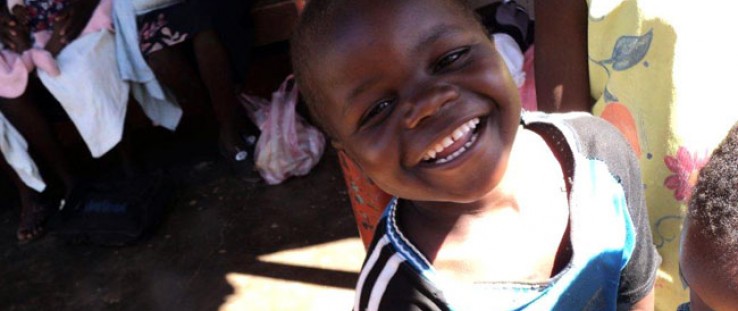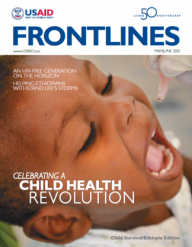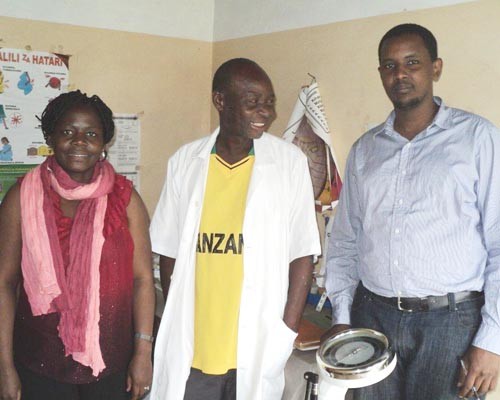 A young boy accompanies his mother and sibling to a rural clinic in Zimbabwe.
Dr. Dyness Kasungami
A young boy accompanies his mother and sibling to a rural clinic in Zimbabwe.
Dr. Dyness Kasungami
 A young boy accompanies his mother and sibling to a rural clinic in Zimbabwe.
Dr. Dyness Kasungami
A young boy accompanies his mother and sibling to a rural clinic in Zimbabwe.
Dr. Dyness Kasungami
Largely a disease of under-development, lack of access to safe water and sanitation, and poor nutrition, acute diarrhea kills children from loss of body fluids, resulting in dehydration. Oral rehydration therapy, including using pre-formulated oral rehydration salts, is the cornerstone of fluid replacement and prevents dehydration and death. It is a simple and inexpensive lifesaving remedy that can be administered in the home.
Nearly 15 years ago, as a resident medical officer at a secondary referral hospital in Zambia, I spent countless nights striving to revive (using intravenous fluid infusions) children with severe dehydration from diarrhea and often severe malnutrition. Referred by local health centers, these children were too weak to take fluids by mouth and their blood vessels were inaccessible as a consequence of dehydration. I saved a few and lost many.
Most of those I saved showed up in a similar condition barely two to three months later because their home conditions had not changed. It was painful knowing that these children could live if mothers gave them oral rehydration solution at home and sought care early. Given the desperate point at which I came in contact with these families, there was no room for health education. I decided that my medical career needed a different focus. I wanted to deal with this problem upstream. One year later, I signed up to work as a medical officer for a rural district, and so started my public health career.
I joined MCHIP in 2010 to lead the child health team. The primary mandate is to increase access to and use of effective interventions against childhood pneumonia; revitalize oral rehydration therapy (ORT); and introduce and scale-up the use of zinc in diarrhea case management. Having spent nearly 10 years pushing integrated health programming, I was ambivalent at advocating what could be perceived as a call for stand-alone diarrhea disease control programs, which we have moved away from since the ’90s.
Related Content
UNICEF/World Health Organization report on children and diarrhea
Reviewing the burden of diarrhea, I also realized that my team had a tough mandate.
Global and country data sums up the status: Diarrhea remains the second leading cause of under-5 deaths globally, after pneumonia, claiming 1.3 million children annually, or a child every 30 seconds. That’s more than deaths from AIDS, malaria and measles combined. Nearly three-quarters of deaths are in 15 countries in sub-Saharan Africa and south Asia, topped by India, Nigeria and the Democratic Republic of Congo.
Besides the needless deaths, the impact of multiple bouts of diarrhea in the formative years of childhood extends long beyond the infection itself and affects both growth and cognitive development in children. These children will not attain a high level of education. Low-cost interventions are available, but these interventions are not reaching the children who need them, particularly those in the poorest households.
A Call for Focus and Scale
Effective interventions that can dramatically prevent fatalities from childhood diarrhea are articulated in the seven-point plan published by UNICEF and the World Health Organization in 2009. All of these interventions, with the exception of vitamin A supplementation, have appallingly limited coverage and, therefore, little impact. For example, access to ORT is as low as 33 percent in developing countries. Nearly 25 percent of people in developing countries still practice open defecation, and hand washing with soap or ash is very low.
USAID staff across the globe work hard to increase access to diarrhea interventions. Partnering with host governments, local communities, NGOs and other donors, USAID uses multiple channels to deliver diarrhea control interventions.
In Kenya and Zimbabwe, for example, MCHIP is supporting national experts to equip diarrhea treatment corners; set operational guidelines to improve quality of case management; and mobilize communities to practice appropriate hygiene and seek care early for diarrheal diseases. USAID technical advisers are part of global coalitions advocating coordinated and focused action on diarrhea disease.
However, the effort remains too fragmented. Global spending to reduce diarrheal disease is disproportionate to its impact. We need staff and more funds to buy and deliver oral rehydration salt and zinc; to train health workers; and to create awareness in affected communities and in policymakers. This greater program effort will take diarrhea prevention and treatment interventions to scale and reach those who most need them. The interventions should be offered not as stand-alone programs, but through the existing platform of other child health services like malaria since, in most cases, children have more than one illness at the same time.
Coordination to Save 800,000
At global and national levels, the time has come for leadership on coordinated approaches to prevent 800,000 needless deaths annually. We need a coalition of public-health practitioners, private-sector investors, habitat planners, civic and traditional leaders, and households to rise to the challenge to finish the diarrhea business. We need to go back to the basics and use new technology to support delivery of old effective interventions like oral rehydration therapy.
Robert Clay, the deputy assistant administrator for USAID’s Bureau for Global Health, said recently that it’s time for a second child survival revolution, and I couldn’t agree more. USAID is rising to the challenge for global leadership for a second child survival revolution through the “Call to Action on Child Survival: A Promise to Keep” planned for June 2012. At this event, USAID is calling on global leaders to renew their commitment, and ensure that every child grows to celebrate their fifth birthday. For many children, diarrhea, which can be easily prevented and treated, robs them of the right to life.










Comment
Make a general inquiry or suggest an improvement.